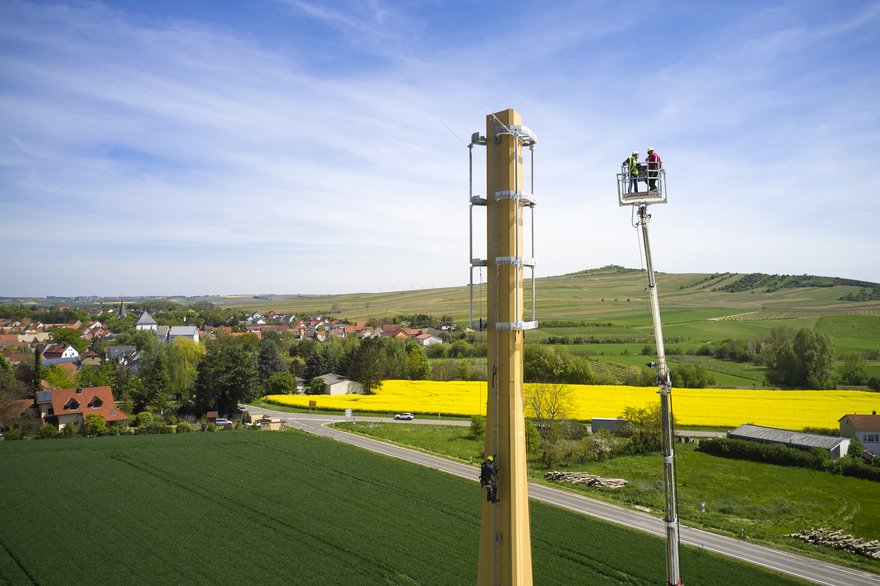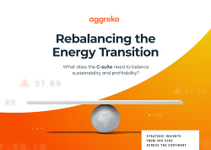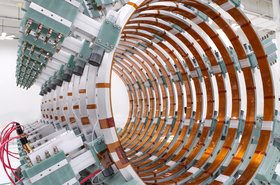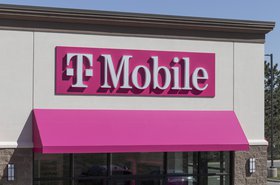“We want our towers to be pleasant to look at, and wood can help us to do that,” says Jean-Claude Geha, chief technology officer at Vantage Towers.
Today the company has 84,600 towers to its name, with most of these structures made from traditional materials such as steel.
However, Vantage has sought to break from the norm and try a different approach with some of its newer tower structures. This is where wood comes in.
Although a very small number - 12, to be precise - of Vantage’s tower portfolio are made from timber, Geha tells DCD that this is symbolic of an industry searching to be more innovative and mindful of the environment.
“I think like many companies, we’ve been driven by a social responsibility to do business in a greener way,” Geha explains.
“We’re looking at different areas where we can become a greener company that will drive us towards a net zero position in the foreseeable future and improve energy consumption, such as looking at the type of material we use to build our towers.
Current deployments
Founded in 2020 by Vodafone, Vantage Towers, not to be confused with Vantage Data Centers, operates across 10 European countries. Voda sold a stake in the towerco in 2022, creating a new joint venture named Oak Holdings alongside KKR and Global Infrastructure Partners (GIP - now owned by BlacRock).
At present, Vantage has deployed its wooden structures in Hungary and Germany, where, in October 2023, the company announced it was building North Rhine-Westphalia's first sustainable wooden-structured telecommunication mast in the town of Neunkirchen, Siegerland.
The 40-meter high Ecopol tower is set to be erected early this year in the Wiederstein district of Neunkirchen, next to the NeunkirchenBurbach railway line.
"The community had actively sought the construction of a wooden mast,” Christian Hillabrant, CEO of Vantage Towers when the tower project was announced. “The excellent cooperation with the municipality is a prime example of how the mobile communications rollout in rural areas can succeed."
So far, Vantage has deployed one wooden structure in Germany, though Geha explains that this tower does have a “very thin layer of steel” inside it to meet regulatory requirements.
“However, I would say the bulk of the material is wood and this wood is laminated and layered. It's constructed of several pieces of wood that are overlaid one on top of the other to create the mass and the strength,” he explains.
“There's also another reason for that. If there's ever any damage to part of the wood, then you don't need to remove the whole section of the tower. You remove the small section that was damaged and then you replace it. So this way you don't take out a section that would jeopardize the standing of the tower.”
Sourcing the wood
As for the wood, Vantage sources the material from Finland, with the wood coming from spruce trees.
Spruce is a tree of the genus Picea, a group of about 40 species of coniferous evergreen trees in the family Pinaceae, found in northern temperate regions.
According to Geha, Vantage uses this particular wood as it is “rigid and pretty strong.”
“It's the same wood that’s used for the construction of homes and multi-dwelling structures. It's very durable.”
He says that wood can last for up to 30 years, giving wooden towers a similar lifespan to their steel counterparts.
As for dealing with elements, Geha says that the material can cope with fire hazards, explaining that the material is naturally retardant.
Wooden towers are put together in a relatively similar manner to steel ones, Vantage explains.
“If you take a concrete tower, usually it comes in one piece with the active equipment already installed and then you just need a crane to put it in the ground and it's relatively fast,” Geha explains.
“As for the wooden tower, they come in different pieces. In the case of the tower in Westphalia, we have three pieces and essentially they just get screwed and glued together.”
According to Vantage, the tower in Westphalia took a day to piece together.
Energy savings
Wood offers a great option to support the subtle inclusion of telecom towers within landscapes, but this is not the only reason why Vantage has pushed the use of the material.
Geha explains that wood can also enable it to deploy more energy-efficient equipment.
When it comes to building wooden towers, Geha says the height is similar to traditional steel structures, usually around 40 meters.
“In Germany, as we build the second and third towers, we will go up in height,” he says. “That means we would be able to cover most of the requirements you need for towers.”
The company claims that by using wood instead of steel, Vantage can reduce its carbon footprint by 50 percent.
A report published by Cogent Engineering estimates that if one percent of telecom towers that are expected to be built in Europe in the next five years use wood instead of steel, more than 17,000 tons of CO2 emissions will be eliminated
Blending in
Geha says Vantage is focused on offering an alternative vision for towers that don’t involve large steel eyesores.
In Germany, the company is working with municipal governments in the Westphalia region to ensure its infrastructure fits in with the existing surroundings.
“We can coat or color the tower in any possible color that is desired by the municipality,” the company explains.
“It sounds like a small thing but in reality, this was a huge factor for the municipality in Westphalia because they wanted to have a new tower, but they said they don't want to have any kind of steel or concrete structure to obstruct the beautiful landscape. They wanted to have something that blended in as well as possible. It might not sound like a big thing, but for the people who live near the tower, it’s a huge bonus.”
Camo towers are becoming more common in the tower industry, with some tower operators using tall trees to disguise their telecom infrastructure, notably FLI Structures. This can serve several purposes, helping to preserve landscapes as well as ensuring communities are unaware of the presence of new towers.
Embrace different
The variety of different types of cell towers or sites is something that the industry should embrace, argues Geha.
“There are more and more options coming out to make sure that these towers blend in with the environment and the landscape where you're at,” he says. “We’re pretty happy about that because then that gives us a lot of options as we build towers now.”
While he notes that the company already has thousands of other traditional towers, there are limitations to how they can upgrade or modify those towers.
As for newer builds, however, he says that Vantage will take a more open-minded approach.
The company confirmed to DCD that it’s conducting trials with other urban furniture, such as smart benches, which it says will host 4G and 5G equipment, provide device charging, and support WiFi hotspots.
“We are also testing smart recycling stations, which combine solar-powered waste management with spaces to house telecom infrastructure, offering sustainability and enhanced urban connectivity,” the company said in a written statement.
“These efforts aim to allow mobile network operators to improve 4G/5G coverage and capacity they need while maintaining the visual appeal of urban spaces.”
Small cells have also been used more by tower companies and telcos, including Crown Castle and the UK’s Virgin Media O2.
They are often located on existing structures, such as lampposts or buildings, and tend to blend in more discreetly than tower structures.
Vantage says it’s already deploying small cells using Smart Cell Sign - discreet illuminated signs for shops that host telecom equipment while improving coverage and capacity at street level.
“Additionally, in Spain, we have deployed a small network of smart lamp poles that illuminate streets while simultaneously hosting 4G and 5G equipment, as well as sensors and cameras, in a way that fits naturally into the urban setting,” the company says.
Challenges
Getting permission to erect wooden towers can be challenging, Geha says.
“I would say time for these new designs to be approved by authorities,” says Geha. “I don't want to blame the authorities. I think it may make sense for them when they see something new, as they need time to absorb the new design and to examine it, and so on before they approve it.”
He adds that the construction is also subtly different from that involved in building a steel tower.
“To be trained on such towers to assemble them is more or less the same process, but you're dealing with a different material,” he says. “You're dealing with slightly different ways of assembling the tower, and so we need to work with our suppliers so that the construction work for us is up to speed.”
He labels the whole process a learning curve for the engineers, authorities, and Vantage themselves.
Thinking 30 years ahead
While the rollout of the wooden towers has been limited thus far to just Hungary and Germany, the long-term goal is to extend to all of its markets.
“The idea here eventually is to have a really sizeable volume of these towers going out and it's not going to be limited to Hungary and Germany. I would like to use them in every market possible,” says Geha.
Though he declined to put a figure on the number of wooden towers Vantage intends to build, Geha said that the company will explore deployments in different environments, while also engaging with regulators ahead of a larger scaler deployment.
He’s adamant, however, about one thing, and that is the longevity of the towers and the role they will play in the future, even if the same wood is reutilized for something else.
“Amongst the three or four options that we have to build a tower, wood is the best in terms of the source of it,” he says. “It comes from replenishable resources. It's reusable once it's been taken down. So, building towers with that material is not more taxing than using other materials. That's why it's very important. I think it's a win-win solution using this material for us.
“In 30 years if the tower is taken down, it can be reused over and over again. Probably not to build another tower but to be used for scaffolding or any sort of applications where you need that kind of wood, so nothing is wasted on a structure like that.”









